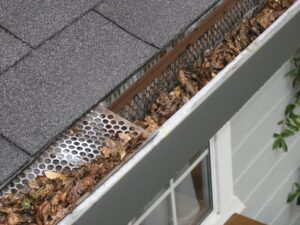Property Expert On How To Rainproof Your Home As The Wet Weather Continues

Property owners looking to rainproof their home need to follow eight steps, a leading expert has advised.
Forecasters are warning that October is likely to bring more of the miserable weather which drenched large parts of the UK through late-September.
Amber alerts for heavy rain were issued by the Met Office – warning of further flooding and travel disruption across large swathes of the UK.
Nearly three inches of rain fell over several hours in the worst-affected regions.
Outlining the risks this can pose to property owners, Jonathan Rolande, the founder of House Buy Fast, said: “The total annual amount of rainfall has increased slightly.
“But the statistics for September show that the total amount isn’t as important as the speed at which it falls.
“Whatever the cause, it is noticeable how much more tropical our summers have become, and the winters are much, much wetter than they once were. And British homes aren’t built for it.
“Don’t get me wrong, our homes are – with some notable exceptions – incredibly well-built with designs that stand the test of time and materials that are second to none.
“The unprecedented volume of rain in short periods has put a strain on the design of our homes that could not have been foreseen by architects and builders in days gone by.
Outlining the eight things all property owners need to do to rainproof their property, Jonathan said:
- Check your roof, gutters and downpipes when it rains. It’s worth getting wet if you spot a problem with blockages – ideally, gutters should be cleared twice a year
- Examine brickwork or render for gaps and cracks. Water penetrating through gaps can cause dampness and, more worryingly, structural damage to the property
- If you can, inspect flat roofs for “ponding”. Even minor ponding can increase the risk of punctures in the roof membrane and water penetration, plus it can cause serious structural damage as the excess weight can exceed the safe weight that a home can carry
- Ventilate rooms when you can, especially after cooking/bathing. A lack of ventilation can cause condensation to settle on walls and windows and quickly lead to mould and damp issues.
- Consider installing vents to problem areas. They can be a very effective way to prevent damp and mould, as fresh air is constantly drawn in to replace humid air.
- Plant a tree! The roots will draw on water accumulating in waterlogged soil and can help stop drainage being overwhelmed during wet periods
- Ensure air bricks are not blocked deliberately or with soil as flower beds gain height over the years. It is easy to overlook these but they are crucial as they allow air to circulated in wall cavities and prevent cold spots and damp on walls
- Check your buildings and contents insurance offers up to date cover. You may find that you are not adequately covered for wetter weather and could be left with hefty bills in the event of a flood
Jonathan added: “Cavity wall insulation can bridge the inside and outside layers of bricks, allowing rain to transfer to the inside walls. Removing soft ground in favour of driveways so rain runs off rather than soaking in.
“Reducing tree numbers that shelter gardens and help to remove excess moisture. Insulation and double glazing make homes almost airtight so any dampness that does penetrate has nowhere to escape.
“Washing and drying clothes indoors, decreasing air circulation due to more possessions and higher density per property can also cause problems.
“Extreme weather seems to be happening more often and homeowners and tenants can do a lot to prevent problems before they arise.”





